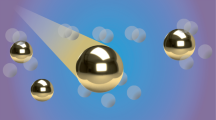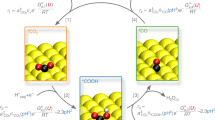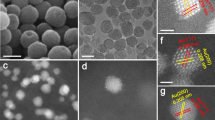Abstract
In heterogeneous catalysis and electrocatalysis, adsorbed carbon monoxide typically acts as a poison or poisoning intermediate in the oxidation of alcohols. However, gold as an (electro)catalyst often exhibits unexpected properties. Here we show that carbon monoxide irreversibly adsorbed on a Au(111) surface in aqueous alkaline media can act as a promoter for the electrocatalytic oxidation of certain alcohols, in particular methanol. In comparison with bare Au(111), the onset potential for methanol oxidation is significantly lower in the presence of adsorbed CO, and formation of the main methanol oxidation products—formaldehyde and formic acid—is enhanced. By studying the effect of adsorbed CO on the oxidation of other alcohols on gold, we conclude that the presence of adsorbed CO promotes beta-hydrogen elimination, that is, C–H bond breaking. Apart from its importance to gold catalysis, this is an unanticipated example of promotion effects by co-adsorbed small molecules in electrocatalysis.
This is a preview of subscription content, access via your institution
Access options
Subscribe to this journal
Receive 12 print issues and online access
$259.00 per year
only $21.58 per issue
Buy this article
- Purchase on Springer Link
- Instant access to full article PDF
Prices may be subject to local taxes which are calculated during checkout





Similar content being viewed by others
References
Bond, G. C., Louis, C. & Thompson, D. T. Catalysis by Gold (Imperial College Press, 2006).
Haruta, M., Kobayashi, T., Sano, H. & Yamada, M. Novel gold catalysts for the oxidation of carbon monoxide at a temperature far below 0 °C, Chem. Lett. 16, 405–408 (1987).
Haruta, M. Catalysis: gold rush. Nature 437, 1098–1099 (2005).
Funakawa, A., Yamanaka, I., Takenaka, S. & Otsuka, K., Selectivity control of carbonylation of methanol to dimethyl oxalate and dimethyl carbonate over gold anode by electrochemical potential. J. Am. Chem. Soc. 126, 5346–5347 (2004).
Ketchie, W., Fang, Y.-L., Wong, M., Murayama, M. & Davis, R. J. Influence of gold particle size on the aqueous-phase oxidation of carbon monoxide and glycerol. J. Catal. 250, 94–101 (2007).
Zope, B. N., Hibbits, D. D., Neurock, M. & Davis, R. J. Reactivity of the gold/water interface during selective oxidation catalysis. Science 330, 74–78 (2010).
Hashmi, A. S. K. & Hutchings, G. J. Gold catalysis. Angew. Chem. Int. Ed. 45, 7896–7936 (2006).
Xu, B., Liu, X., Haubrich, J., Madix, R. J. & Friend, C. M. Selectivity control in gold-mediated esterification of methanol. Angew. Chem. Int. Ed. 48, 4206–4209 (2009).
Xu, B., Liu, X., Haubrich, J. & Friend, C. M. Vapour-phase gold-surface-mediated coupling of aldehydes with methanol. Nature Chem. 2, 61–65 (2010).
Roberts, J. L. Jr & Sawyer, D. T. Electrochemical oxidation of carbon monoxide at gold electrodes, Electrochim. Acta 10, 989–1000 (1965).
Kita, H., Nakajima, H. & Hayashi, K. Electrochemical oxidation of CO on Au in alkaline solution. J. Electroanal. Chem. 190, 141–156 (1985).
Burke, L. D. & Nugent, P. F. The electrochemistry of gold: II the electrocatalytic behaviour of the metal in aqueous media. Gold Bull. 31, 39–50 (1998).
Rodriguez, P., Feliu, J. M. & Koper, M. T. M. Unusual adsorption state of carbon monoxide on single-crystalline gold electrodes in alkaline media. Electrochem. Commun. 11, 1105–1108 (2009).
Rodriguez, P., Koverga, A. A. & Koper, M. T. M. Carbon monoxide as a promoter for its own oxidation on a gold electrode. Angew. Chem. Int. Ed. 49, 1241–1243 (2010).
Rodriguez, P., Garcia-Araez, N. & Koper, M. T. M. Self-promotion mechanism for CO electrooxidation on gold. Phys. Chem. Chem. Phys. 12, 9373–9380 (2010).
Rodriguez, P., Garcia-Araez, N., Koverga, A. A., Frank, S. & Koper, M. T. M. CO electrooxidation on gold: a combined electrochemical, spectroscopic and DFT study. Langmuir 26, 12425–12432 (2010).
Beden, B., Leger, J. M. & Lamy, C. in Modern Aspects of Electrochemistry Vol. 22 (eds Bockris, J. O'M., Conway, B. E. & White, R. E.) 97–264 (Plenum Press, 1992).
Lai, S. C. S. et al. Effects of electrolyte pH and composition on the ethanol electro-oxidation reaction. Catal. Today 154, 92–104 (2010).
Kwon, Y., Lai, S. C. S., Rodriguez, P. & Koper, M. T. M. Electrocatalytic oxidation of alcohols on gold in alkaline media: base or gold catalysis? J. Am. Chem. Soc. 133, 6914–6917 (2011).
Borkowska, Z., Tymosiak-Zielinska, A. & Shul, G. Electrooxidation of methanol on polycrystalline and single crystal gold electrodes. Electrochim. Acta 49, 1209–1220 (2004).
Tremiliosi-Filho, G. et al. Electro-oxidation of ethanol on gold: analysis of the reaction products and mechanism. J. Electroanal. Chem. 444, 31–39 (1998).
Kwon, Y. & Koper, M. T. M. Combining voltammetry with HPLC: application to electrooxidation of glycerol. Anal. Chem. 82, 5420–5424 (2010).
Koper, M. T. M., Lai, S. C. S. & Herrero, E. in Fuel Cell Catalysis (ed. Koper, M. T. M.) 159–207 (Wiley, 2009).
Strmcnik, D. et al. The role of non-covalent interactions in electrocatalytic fuel-cell reactions on platinum. Nature Chem. 1, 466–473 (2009).
Strmcnik, D. et al. Enhanced electrocatalysis of the oxygen reduction reaction based on patterning of platinum surfaces with cyanide. Nature Chem. 2, 880–885 (2010).
Cuesta, A. At least three contiguous atoms are necessary for CO formation during methanol electrooxidation on platinum. J. Am. Chem. Soc. 128, 13332–13333 (2006).
Stoffelsma, C. et al. Promotion of the oxidation of carbon monoxide at stepped platinum single-crystal electrodes in alkaline media by lithium and beryllium cations. J. Am. Chem. Soc. 132, 16127–16133 (2010).
Hernandez, J., Solla-Gullon, J., Herrero, E., Aldaz, A. & Feliu, J. M. Methanol oxidation on gold nanoparticles in alkaline media: unusual electrocatalytic activity. Electrochim. Acta 52, 1662–1669 (2006).
Avramov-Ivic, M., Adzic, R. R., Bewick, A. & Razaq, M. An investigation of the oxidation of formaldehyde on noble metal electrodes in alkaline solutions by electrochemically modulated infrared spectroscopy. J. Electroanal. Chem. 240, 161–164 (1988).
Beltramo, G. L., Shubina, T. E. & Koper, M. T. M. Oxidation of formic acid and carbon monoxide on gold electrodes studied by surface-enhanced Raman spectroscopy and DFT. ChemPhysChem 6, 2597–2606 (2005).
Nakamoto, K. Infrared and Raman Spectra of Inorganic and Coordination Compounds 232 (Wiley, 1986).
Gribov, L. A., Novakov, I. A., Pavlyuchko, A. I. & Shumovskii, O. Y. Spectroscopic calculation of the bond-dissociation energy of CH bonds in fluoro derivatives of methane, ethane, ethene, propene, and benzene. J. Struct. Chem. 48, 400–406 (2007).
Gellman, A. J. & Dai, Q. The mechanism of β-hydride elimination in adsorbed alkoxides. J. Am. Chem. Soc. 115, 714–722 (1993).
Chen, A. & Lipkowski, J. Electrochemical and IR spectroscopic studies of OH adsorption at the Au(111) electrode surface. J. Phys. Chem. B 103, 682–691 (1999).
Zhang, T. et al. Stabilising CO on Au with NO2: electronegative species as promoters on coinage metals? Phys. Rev. Lett. 95, 266102 (2005).
Acknowledgements
P.R. and M.T.M.K. acknowledge financial support from the Netherlands Organization for Scientific Research (NWO) through VENI and VICI grants, respectively, and the European Commission (through FP7 Initial Training Network ‘ELCAT’, grant agreement no. 214936-2). The research of Y.K. is performed within the framework of the CatchBio programme. The authors gratefully acknowledge support from the Smart Mix Program of The Netherlands Ministry of Economic Affairs and The Netherlands Ministry of Education, Culture and Science. The purchase of the HPLC and fraction collection system was made possible through an ‘NWO-Middelgroot’ equipment grant awarded to M.T.M.K. by NWO.
Author information
Authors and Affiliations
Contributions
P.R. and M.T.M.K. conceived and designed the experiments. P.R. performed the electrochemistry and FTIR experiments. P.R. and Y.K. performed the HPLC experiments. All authors contributed to the data analysis. P.R. and M.T.M.K. co-wrote the paper.
Corresponding author
Ethics declarations
Competing interests
The authors declare no competing financial interests.
Supplementary information
Supplementary information
Supplementary information (PDF 3021 kb)
Rights and permissions
About this article
Cite this article
Rodriguez, P., Kwon, Y. & Koper, M. The promoting effect of adsorbed carbon monoxide on the oxidation of alcohols on a gold catalyst. Nature Chem 4, 177–182 (2012). https://doi.org/10.1038/nchem.1221
Received:
Accepted:
Published:
Issue Date:
DOI: https://doi.org/10.1038/nchem.1221
This article is cited by
-
Alcohols electrooxidation coupled with H2 production at high current densities promoted by a cooperative catalyst
Nature Communications (2022)
-
Flexible Au micro-array electrode with atomic-scale Au thin film for enhanced ethanol oxidation reaction
Nano Research (2021)
-
Electrochemical Oxidation of Carbon Monoxide on Unsupported Gold Nanospheres in Alkaline Medium
Electrocatalysis (2021)
-
Materializing efficient methanol oxidation via electron delocalization in nickel hydroxide nanoribbon
Nature Communications (2020)
-
Towards molecular understanding of local chemical environment effects in electro- and photocatalytic CO2 reduction
Nature Catalysis (2020)



